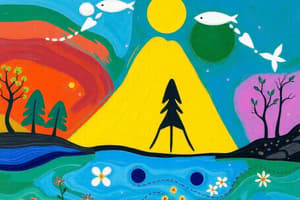Podcast
Questions and Answers
What are biogeochemical cycles?
What are biogeochemical cycles?
Overall chemical cycles through both the biological and geological world.
Which of the following is a component of biogeochemical cycles?
Which of the following is a component of biogeochemical cycles?
- Reservoirs
- Exchange Pools
- Both A and B (correct)
- None of the above
Which cycle is also known as the hydrologic cycle?
Which cycle is also known as the hydrologic cycle?
- Nitrogen Cycle
- Water Cycle (correct)
- Phosphorous Cycle
- Carbon-Oxygen Cycle
The sun supplies energy during the water cycle.
The sun supplies energy during the water cycle.
What is evaporation?
What is evaporation?
What does the carbon-oxygen cycle describe?
What does the carbon-oxygen cycle describe?
What is respiration in the carbon-oxygen cycle?
What is respiration in the carbon-oxygen cycle?
What is nitrogen fixation?
What is nitrogen fixation?
The process of converting ammonia into nitrate is called __________.
The process of converting ammonia into nitrate is called __________.
The phosphorus cycle has only one form of phosphorus, which is phosphate.
The phosphorus cycle has only one form of phosphorus, which is phosphate.
What initiates the phosphorus cycle?
What initiates the phosphorus cycle?
Flashcards are hidden until you start studying
Study Notes
Biogeochemical Cycles
- Biogeochemical cycles refer to the chemical cycles through both the biological and geological world.
- Each chemical has a unique cycle, but all share commonalities.
Reservoirs and Exchange Pools
- Reservoirs: Areas where chemicals are held in large quantities for long periods (e.g., oceans, lakes).
- Exchange Pools: Areas where chemicals are held for shorter periods (e.g., clouds, lungs).
Key Biogeochemical Cycles
- Water Cycle (Hydrologic Cycle): The movement of water through various states (vapor, liquid, soil) throughout the environment.
- Evaporation: Liquid water changes to gaseous vapor.
- Transpiration: Biological process where water vapor is released from plants.
- Condensation: Water vapor changes back to liquid, forming dew, fog, or clouds.
- Precipitation: Water falls back to Earth in forms like rain, snow, or hail.
- Carbon-Oxygen Cycle: The movement of carbon between the biosphere, atmosphere, oceans, and geosphere.
- Respiration: Organisms combine oxygen and carbohydrates to produce carbon dioxide, water, and energy (O2 + Carbohydrates = CO2 + H2O + energy).
- Photosynthesis: Plants use carbon dioxide and water to produce oxygen.
- Nitrogen Cycle: The conversion of nitrogen gas into nitrogen compounds through the atmosphere, soil, and organisms.
- Nitrogen Fixation (Atmosphere): Lightning converts nitrogen gas into nitrates.
- Nitrogen Fixation (Soil): Rhizobium bacteria in legumes convert atmospheric nitrogen (N2) into ammonia that plants can use.
- Nitrification: Bacteria convert ammonia into nitrate.
- Assimilation: Plants and animals incorporate nitrate and ammonia into their tissues.
- Ammonification: Bacteria convert ammonia from dead organisms and waste into ammonium.
- Denitrification: Bacteria convert nitrate back into nitrogen gas, returning it to the atmosphere.
- Phosphorus Cycle: The transformation and movement of phosphorus in soil, water, and living organisms.
- Weathering: Phosphorus is released from rocks through weathering.
- Absorption by Plants: Plants absorb phosphate salts from the soil.
- Absorption by Animals: Animals obtain phosphorus from plants or by consuming other animals.
- Return to Ecosystem: When organisms die, decomposers release phosphorus back into the soil and water.
- Sedimentation: Phosphorus can accumulate in sediments and rocks, eventually being released through weathering, completing the cycle.
Studying That Suits You
Use AI to generate personalized quizzes and flashcards to suit your learning preferences.




